The Royal Netherlands Navy is the naval force of the Kingdom of the Netherlands. It is one of the four Netherlands Armed Forces. It was founded on 8 January 1488, making it the third oldest naval force in the world.

The Goalkeeper CIWS is a Dutch close-in weapon system (CIWS) introduced in 1979. It is an autonomous and completely automatic weapon system for short-range defence of ships against highly maneuverable missiles, aircraft and fast-maneuvering surface vessels. Once activated the system automatically undertakes the entire air defence process from surveillance and detection to destruction, including the selection of the next priority target.
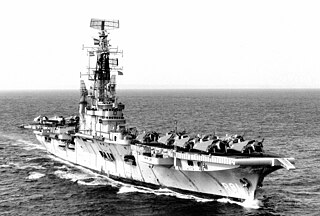
HNLMS Karel Doorman (R81) was a Colossus-class aircraft carrier of the Royal Netherlands Navy. Formerly the British ship HMS Venerable, she was sold to the Netherlands in 1948 as a light attack carrier. In 1960, she was involved in the decolonization conflict in Western New Guinea with Indonesia. In the mid 1960s, her role was changed to anti-submarine warfare carrier and only ASW aircraft and helicopters were carried. An engine room fire took her out of service in 1968. She was sold to Argentina in 1969 and renamed ARA Veinticinco de Mayo.

The Karel Doorman-class frigates are a series of eight multi-purpose vessels built for the Royal Netherlands Navy. Its namesake is Karel Doorman, a Dutch naval officer whose ship was struck by a Japanese torpedo in the battle of the Java Sea in 1942, and who, as a result of which, went down with his ship.

The De Zeven Provinciën class was a class of light cruisers. They were built by Rotterdamsche Droogdok Maatschappij (RDM) and Wilton-Fijenoord for the Royal Netherlands Navy. The name De Zeven Provinciën refers to the seven provinces which formed the Dutch Republic in 1581.

The Zwaardvis-class submarine ("Swordfish") is a class of conventional attack submarines that were built to strengthen the Royal Netherlands Navy. The Dutch government opted for the choice to not replace the two Zwaardvis-class submarines with either more Walrus-class submarines, or submarines of a new design.

The four De Zeven Provinciën-class frigates are air-defence and command frigates in service with the Royal Netherlands Navy. This class of ships is also known as "LCF". The ships are similar to the German Sachsen-class frigates in role and mission.
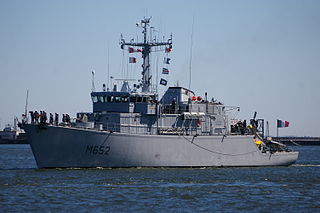
The Tripartite class is a class of minehunters developed from an agreement between the navies of Belgium, France and the Netherlands. A total of 35 ships were constructed for the three navies. The class was constructed in the 1980s–1990s in all three countries, using a mix of minehunting, electrical and propulsion systems from the three member nations. In France, where they are known as the Éridan class they are primarily used as minehunters, but have been used for minesweeping and ammunition transport in Belgium and the Netherlands, where the Tripartites are known as the Alkmaar class.

The Holland-class destroyers were built for the Royal Netherlands Navy in the 1950s. They were the first major warships designed and built by the Dutch after World War II. In contrast to previous Dutch Navy practice the ships were named after provinces rather than admirals.

HNLMS Karel Doorman is a multi-function support ship for amphibious operations of the Royal Netherlands Navy, which is also used by the German Navy. The ship replaced both of the navy's replenishment oilers: HNLMS Zuiderkruis and HNLMS Amsterdam. At 204.7 m she is the largest ship in service with the Royal Netherlands Navy.

HNLMS Rotterdam is the lead ship in the Rotterdam-class landing platform dock of the Royal Netherlands Navy. The ship is named after the Dutch city of Rotterdam.
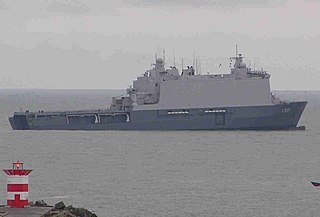
HNLMS Johan de Witt is the second Rotterdam-class landing platform dock of the Royal Netherlands Navy. It is an improved design of Rotterdam, which was designed in conjunction between the Netherlands and Spain. The ship, displacing 16,800 tons, was launched on 13 May 2006. The motto of the ship is Ago Quod Ago, translated as I do what I do.
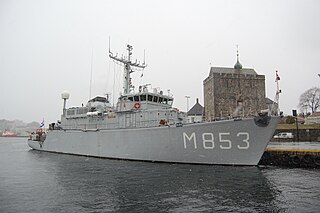
The Alkmaar class is a ship class of fifteen minehunters that were built in the Netherlands for the Royal Netherlands Navy. They are based on the design of the Tripartite class, which was developed by a collaborative effort between the Netherlands, Belgium and France, and replaced the minesweepers and minehunters of the Dokkum class.

HNLMS Dolfijn (S808) is a Walrus-class submarine of the Royal Netherlands Navy. She entered service in 1993 as the third submarine of the Walrus class, after HNLMS Walrus and HNLMS Zeeleeuw. Dolfijn has been deployed both for naval exercises and in combat operations around the world. Furthermore, the submarine plays an important role by performing intelligence operations.
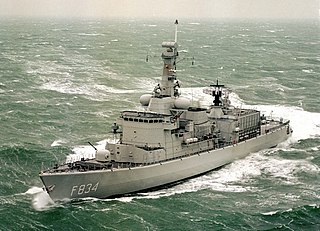
HNLMS Van Galen (F834) is a ship of the Karel Doorman class of multi-purpose frigates of the Royal Netherlands Navy. Built by the shipyard Koninklijke Schelde Groep in Vlissingen. The ship is named after captain and convoy commander Johan van Galen and served from 1994 to 2008 with the Dutch navy. The radio call sign of the frigate was "PAMG". In 2009 HNLMS Van Galen was sold Portugal. The ship was transferred in 2010 to the Portuguese Navy, where the ship was put into service as the NRP Dom Francisco de Almeida (F334).

The Roofdier class was a class of six frigates that were built in the United States as Patrol Craft Escorts (PCE) for the Netherlands. The frigates were loaned to the Royal Netherlands Navy as part of the Mutual Defense Assistance Act (MDAP) and from 1954 to 1984 served as the Roofdier-class frigates.

Konarak is a Hendijan-class support vessel of the Iranian Navy. It was built in the Netherlands and has been in service since 1988. Originally intended as a support and logistics ship, Konarak was overhauled in 2018, and was armed with anti-ship missiles. The vessel was struck by a missile fired from the Iranian frigate Jamaran in a friendly fire incident during training on 10 May 2020, killing 19 sailors.
In April 2018, the Dutch Government approved a multi-year investment program for the Dutch Navy and allocated funds for the 2018–2030 period. The Dutch Defence Materiel Administration (DMO) is in charge of the procurement of these new ships.

HNLMS Den Helder is a new replenishment oiler under construction for the Royal Netherlands Navy. Also known as the Combat Support Ship (CSS), Den Helder is planned to fill the gap of replenishment at sea that was left after HNLMS Amsterdam was sold to Peru in 2014.

The Netherlands and Belgium are doing a joint procurement for the replacements of the Tripartite-class/Alkmaar-class minehunters. Both countries want to procure six new mine countermeasure (MCM) vessels, which makes for a total of 12 MCM ships. The new MCM ships, developed by Naval Group, will include a range of unmanned systems including unmanned surface, aerial and underwater vehicles alongside towed sonars and mine identification and neutralization ROVs.


















